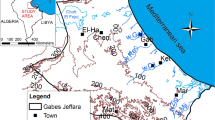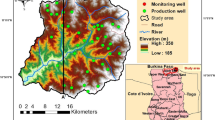Abstract
The Chennai aquifer system, which occupies an area of 6629 km2, is one of the most stressed aquifer systems in southern India and is under severe threat of over exploitation and quality deterioration. This is due to the increasing groundwater abstraction for irrigation, domestic, industrial purposes and for drinking water supply to the ever-expanding Chennai city. To offset the effect of this heavy extraction a paradigm shift towards groundwater management was imperative. A multidisciplinary integrated approach was used to map the aquifers, delineate their geometry, to determine the hydraulic behavior of the aquifer system, and to formulate an aquifer management plan through the development of a groundwater flow model. The main aquifers in the area include weathered and fractured crystalline rocks and recent alluvial formation. Alluvium is the most significant aquifer system in the study area, and this aquifer contains potable quality groundwater except in the eastern part of the study area that has been affected by seawater intrusion. A two-layered groundwater flow model was developed using Visual MODFLOW classic version 4.6 with a 1 km2 grid pattern to simulate groundwater flow for a period of 9 years. The model was calibrated under steady and transient state conditions and allowed components of the water balance of the system to be determined at a regional scale. The simulated results indicate that this aquifer system is under tremendous stress at the prevailing groundwater withdrawal rate of 899 million cubic meter (mcm)/year and would become unstable with the predicted 25% increase in groundwater withdrawal by 2025. However, the interventions to recharge an additional 54 mcm of water could help mitigate the current decline in potentiometric heads and could partially help to arrest the further advancement of seawater intrusion. A scenario of maintaining flow in rivers for a period of 120 days each year coupled with the construction of an unlined canal shows increase in groundwater head and development of the groundwater mounds, which are positive signs for arresting the decline of the water table and pushing saline groundwater in a seaward direction. As a result of the high rate of groundwater depletion in the area, management strategies need to be implemented urgently in the region. These strategies should include the regulation of groundwater abstraction and maintaining an extended flow period in the rivers. These measures are required to improve the sustainability of the available groundwater resources of the region.














Similar content being viewed by others
Data availability
All data used in the study are originally generated during the study and is available with the corresponding author upon reasonable request. All data are provided as tables and figures in this article.
References
Anderson MP, Woessner WW (1992) Applied groundwater modeling—simulation of flow and advective transport. Academic Press, Inc., San Diego, CA, 381p
Araujo LM, Fraca AB, Potter PE (1999) Hydrogeology of Mercosul aquifer system in the Parana and Chaco-Parara Basin, South America, and comparison with the Navajo-Nugget aquifer system, USA. Hydrogeol J 7:317–336
Bianchi M, Kearsey T, Kingdon A (2015) Integrating deterministic lithostratigraphic models in stochastic realizations of subsurface heterogeneity. Impact on predictions of lithology, hydraulic heads and groundwater fluxes. J Hydrol 531:557–573
Central Ground Water Board (2015) Report of the Ground Water Resource Estimation Committee Ministry of Water Resources, Govt. of India. http://cgwb.gov.in/Documents/GEC2015_Report_Final%2030.10.2017.pdf
CGWB (2012) Manual on aquifer mapping. Central Ground Water Board, CHQ, Faridabad, p 77
CGWB (2017) Report on aquifer mapping and groundwater management of Chennai aquifer system. Principal author Dr M. Senthilkumar, p 56. http://cgwb.gov.in/AQM/NAQUIM_REPORT/TAMILNADU/chennaiAquifersystem.pdf
De Caro M, Crosta GB, Frattini P (2017) Hydrogeochemical characterization and natural background levels in urbanized areas: Milan Metropolitan area (Northern Italy). J Hydrol 547:455–473
De Caro M, Perico R, Crosta GB, Frattini P, Volpi G (2020) A regional-scale conceptual and numerical groundwater flow model in fluvio-glacial sediments for the Milan Metropolitan area (Northern Italy). J Hydrol Region Stud. https://doi.org/10.1016/j.ejrh.2020.100683
Heinl M, Thorweihe M (1993) Groundwater resources and management in SW Egypt. Catena Suppl 26:99–121
Idrysy EI, De Smedt F (2006) Modelling groundwater flow of the Trifa aquifer, Morocco. Hydrogeol J 14:1265–1276
Kinzelbach W (1986) Groundwater modelling: an introduction with sample programs in basie. In: Developments in water science, vol. 25. Elsevier, New York, 333p
Lachassagne P, Dewandel B, Wyns R (2021) Review: Hydrogeology of weathered crystalline/hard-rock aquifers—guidelines for the operational survey and management of their groundwater resources. Hydrogeol J 29:2561–2594. https://doi.org/10.1007/s10040-021-02339-7
McDonald MG, Harbaugh AW (1998) User’s documentation forMODFLOW-98, an update to the U.S. Geological Survey modular finite-difference groundwater flow model. In: US Geology Survey Open-File Rep 96-485, p 56
PisinarasV PC, Tsihrintzis VA (2007) A groundwater flow model for water resources management in the Ismarida plain, North Greece. Environ Model Assess 12:75–89. https://doi.org/10.1007/s10666-006-9040-z
Ray RK, Syed TH, Saha D, Sarkar BC (2020) Modeling the impact of rainfall variations and management interventions on the groundwater regime of a hard-rock terrain in central India. Hydrogeol J 28:1209–1227. https://doi.org/10.1007/s10040-020-02132-y
Rushton KR, Redshaw SC (1979) Seepage and groundwater flow. Wiley, New York, p 330
Saha D, Ranjan R (2018) Groundwater resources of India: potential, challenges and management. In: Sikdar P (ed) Groundwater development and management, issues and challenges in South Asia. https://doi.org/10.1007/978-3-319-75115-3_2. Springer, New York
Senthilkumar M, Elango L (2004) Three-dimensional mathematical model to simulate groundwater flow in the lower Palar River basin, southern India. Hydrogeol J 12(4):197–208
Senthilkumar M, Gnanasundar D (2021) Application of Cl/Br ratio to demarcate the fresh-saline water interface in coastal aquifers of northern Tamilnadu, Southern India. Groundw Sustain Dev 15:2352–2801. https://doi.org/10.1016/j.gsd.2021.100658
Senthilkumar M, Gnanasundar D, Sampath Kumar E (2018) Deciphering freshwater/saline water interface in and around northern Chennai Region, Southern India. In: Saha D et al (eds) Clean and sustainable groundwater in India. Springer Hydrogeology, New York, pp 25–38. https://doi.org/10.1007/978-981-10-4552-3_3
Sundararajan N, Sankaran S (2020) Groundwater modeling of Musi basin Hyderabad, India: a case study. Appl Water Sci 10:14. https://doi.org/10.1007/s13201-019-1048-z
Watson C, Richardson J, Wood B, Jackson C, Hughes A (2015) Improving geological and process model integration through TIN to 3D grid conversion. Comput Geosci 82:45–54
World Bank report (2006), India Water economy—bracing for a turbulent future. Oxford University Press, Oxford. ISBN-13: 978-0-19-568333-2, p 103
Acknowledgements
The authors expresses their sincere gratitude to the Chairman of the Central Ground Water Board, Faridabad. The authors express their heartfelt thanks to the Members of the board. Thanks are also expressed to the Head of Office, CGWB, SECR and all the officers and officials of CGWB, SECR, Chennai for their support and encouragement during the study. The authors express their heartfelt thanks to Mr Arumugam, Ms Mini Chandran and Dr Ramesh Kumar, Scientists of CGWB, Chennai for their support during the study. Sincere thanks to the anonymous reviewer and editorial board for the valuable suggestions in revising the manuscript.
Author information
Authors and Affiliations
Contributions
Both the authors have made equal contribution in the study and also in the preparation of the manuscript.
Corresponding author
Ethics declarations
Conflict of interest
The authors declare that they have no conflict of interest.
Ethics approval and consent to participate
Not applicable.
Consent for publication
Not applicable.
Additional information
Publisher's Note
Springer Nature remains neutral with regard to jurisdictional claims in published maps and institutional affiliations.
Rights and permissions
About this article
Cite this article
Senthilkumar, M., Gnanasundar, D. Aquifer characterization and hydrogeological modeling for devising groundwater management strategies for the Chennai aquifer system, southern India. Environ Earth Sci 81, 187 (2022). https://doi.org/10.1007/s12665-022-10280-5
Received:
Accepted:
Published:
DOI: https://doi.org/10.1007/s12665-022-10280-5




